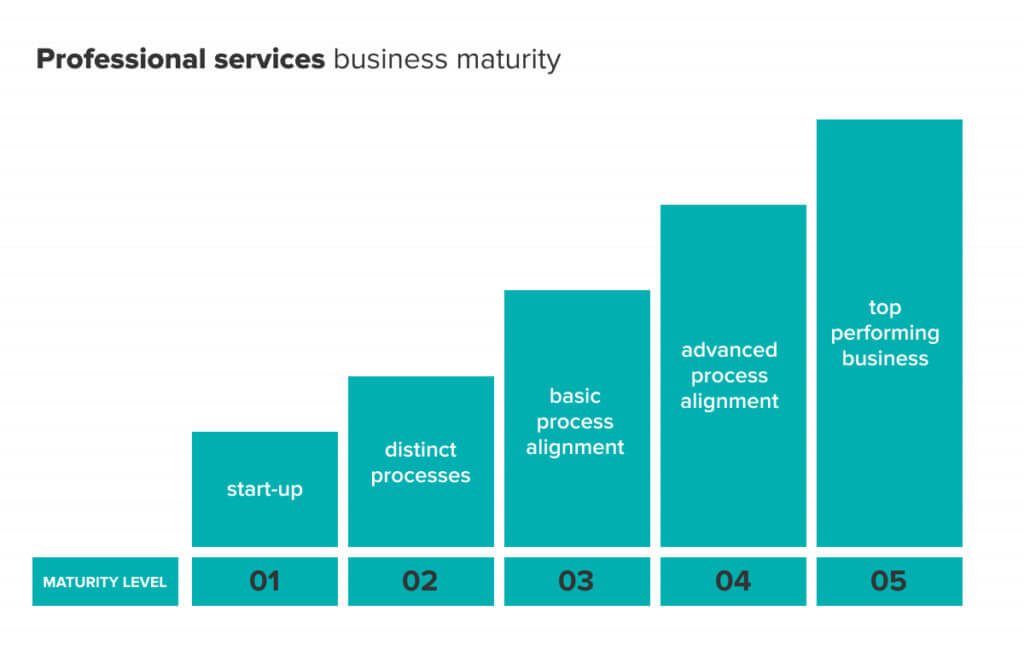
How to increase the efficiency of your professional services business
Content
As professional services firms grow and mature, both new opportunities and new challenges arise. Some companies adjust and increase their performance levels while other organisations lag behind.
Why is that? Studies conducted by Service Performance Insight Research show that “high levels of performance have far more to do with leadership focus, organizational alignment, effective business processes and disciplined execution than ‘time in grade’ [how many years an organisation has been in business]”.
In this article I describe performance improvements that can be achieved with Professional Services Automation systems in conjunction with other software (you can find a list at the end of this post). This applies to all subcategories of professional services firms, including management consultancies, IT consultancies, architecture and engineering practices, law firms, accountancies, specialised design companies, research and development organizations and marketing agencies.
Business maturity levels and beneficial software
The insights I present here are based on my experience implementing and using PSA and CRM in numerous countries across the world. They are supported by invaluable resources published by David Hofferberth and Jeanne Urich in their Service Performance Insight 2020 Professional Services Maturity™ Benchmark, which distinguishes five levels of maturity. I recommend tools for each level and describe the specific features that will help professional services firms increase productivity. Microsoft Dynamics 365 Project Service Automation and Microsoft Dynamics 365 Project Operations are used as examples for PSA software.

Maturity Level 1: Start-up professional services firm
Companies need to start small. And professional services firms are no different. Start-ups tend to outsource back-office functions such as marketing and accounting and rely on rudimentary IT solutions such as company website, Microsoft Office, and Microsoft Teams. At this stage directors need to decide what their company will specialise in.
Sales, project management, resource management and billing: Until your processes solidify and your headcount reaches 10, there is little benefit in adding CRM or PSA to the software mix.
Maturity Level 2: Firm with distinct processes in each department
As professionalism within sales and delivery functions grows and a company’s size exceeds 25 people, it is time to consider additional systems that will increase productivity. At this stage different functions start to demand software that will work for them: SEO and lead generation for marketing, opportunity management for sales, project management software for delivery.
Sales: Sales will benefit from using Dynamics 365 Project Service Automation for opportunity management.
Project management: Delivery should use Dynamics 365 Project Service Automation for managing timesheets.
Resource management: The company may yet be unripe to benefit from resource management features in Dynamics 365 Project Service Automation.
Billing: The company may not be large enough to benefit fully from invoicing features of Dynamics 365 Project Service Automation .
Maturity Level 3: Firm with basic process alignment across departments
At this stage business processes are well established. The headcount probably now exceeds 50 people. Marketing, sales, delivery and finance follow their own processes and people working in these teams are specialists in their fields.
If a central Project Management Office (PMO) has been established, certain levels of consistency in project management practises may be in place. Marketing, sales and delivery use the same integrated CRM/PSA system. Some process alignment across functions thanks to using one platform has been established but tensions remain.
Sales: Dynamics 365 Project Service Automation should be used for managing products, leads, opportunities, quotes, sales forecasting, and contracts. An estimation process with management approval should be in place.
Project management: Dynamics 365 Project Service Automation should be used for actively managing project progress, scope and change orders, approvals of time entries and expenses, cost and revenue budgeting and forecasting as well as for project profitability and utilization reporting. Often other project management tools are used alongside PSA solution.
Resource management: Dynamics 365 Project Service Automation is used for managing resources on at least some projects, but typically not enough information is recorded in the system for effective company-wide resource management.
Billing: Invoices are generated in the solution or invoice data is exported for billing to a financial management/ERP system (QuickBooks, Deltek, Microsoft Dynamics 365 Finance, NetSuite, SAP, Datev, Infor or Sage).
Maturity Level 4: Professional services firm with advanced process alignment across departments
At this level, processes have been aligned across functions to achieve leverage. Directors have implemented a complete set of financial and quality operating controls and measurements and understand very well that ‘You get what you measure’.
These measurements include quantitative and qualitative goals for customer acquisition, retention, and penetration. Employees have opportunities to develop business process and vertical skills in addition to technical and project ones and can benefit from career ladder and mentoring programs.
Sales: Dynamics 365 Project Service Automation is used for global pricing and contract management. Managed accounts and partner programs have been implemented in the system.
Project management: The company uses integrated program and project management. Gantt Chart in Project Operations is used to visualise tasks’ dependencies, milestones, and constraints. Project plan, budget and forecast baselining and versioning can also be used. Global PMO is well established and is responsible for program and project management made more transparent thanks to dashboards built in Power BI.
Resource management: The company optimizes the usage of its resources between countries. Assigning resources who can do the job best rather than local resources has become the norm. Schedule Board in Dynamics 365 Project Service Automation and Project Operations is used in innovative ways to increase visibility of workloads across lines of business, specialties, regions, etc. and to match capacity with demand.
Billing: CRM, PSA and financial management have been fully integrated. Few errors in time entries pass through approval that is automated where it is feasible. Project managers or PMOs use billing frequency, payment milestones linked to project tasks and invoice templates for an automatic generation of draft invoices resulting in quicker billing cycles. Accounting can recognize revenue based on real-time project progress and uses Project Accounting features in the financial software (Project Operations with Project Finance).
Maturity Level 5: Top performing professional services business
At this level, the rough edges between disciplines, functions, and specialties have been smoothed. Directors have implemented continual checks and balances to assure superior utilization and billing rates. The following systems and processes are in place and continuously enhanced:
- Fully integrated financial management system
- CRM
- Resource management
- Contracts and pricing systems
- Monitoring and controlling
Sales: Diverse Sales teams have now transformed into vertical centers of excellence.
Project management: Global PMO now has complete visibility of global project quality.
Resource management: Global PMO uses a Schedule Board for multi-disciplinary resource management.
Billing: A financial management/ERP system has been integrated with systems used by partners and clients. EDI billing is used to ensure real-time invoicing while expense and cost recovery systems help to ensure that invoices get paid on time.
Improved productivity and profit through process alignment
Professional service firms can make quantum leaps in improving productivity and profit. When marketing, sales, delivery, HR, and accounting use the same software platform further business processes, alignment across departments is possible. Microsoft Dynamics 365 Project Service Automation and Microsoft Dynamics 365 Project Operations (available from October 2020) can get professional services companies closer to achieving that goal.
Primary business applications used by professional services firms
– Enterprise Resource Planning (ERP): The fundamental solution required to accurately collect and report financial transactions.
– Customer Relationship Management (CRM): The automation of client relationship processes to improve sales and marketing efficiency and effectiveness.
– Professional Services Automation (PSA): The initiation, planning, execution, close and control of projects and services through the management and scheduling of resources that include people (both internal and partners). May include materials and equipment.
– Human Capital Management (HCM): Talent management solutions for recruiting, hiring, compensation, goal setting and career and performance management which rely on integration with and extracts from the employee database.
– Business Intelligence (BI): The assembly and use of information to improve decision-making.










